Avian Influenza, or bird flu as it is commonly known, generally poses a threat to the poultry industry from October onwards. However, 2022 has been very unusual, with commercial cases in the UK throughout the year and wild bird cases beginning here in early July. At the time of writing, there have been two commercial cases confirmed in Ireland. These have both been in turkey flocks in Co Monaghan. All birds have been culled on these sites as a result.
As a result of a confirmed highly pathogenic avian influenza (HPAI) outbreak, restriction zones have been put in place. Within these zones, there are additional protection and surveillance required. All poultry keepers in these zones are legally required to comply with the regulations.
Biosecurity is crucial for the protection of poultry units, now more so than ever. While the Department of Agriculture, Food and the Marine has introduced a housing order from 7 November, biosecurity must remain in place in the strictest of measures.
Biosecurity is a set of preventative measures put in place to reduce the risk of introducing harmful bacteria, viruses or pathogens; and minimise the spread of already present disease-causing agents throughout the farm.
Operational biosecurity is ever more important in times of high disease risk. These are the day-to-day measures put in place by the farmer to ensure the farm is free from disease (see graph below).
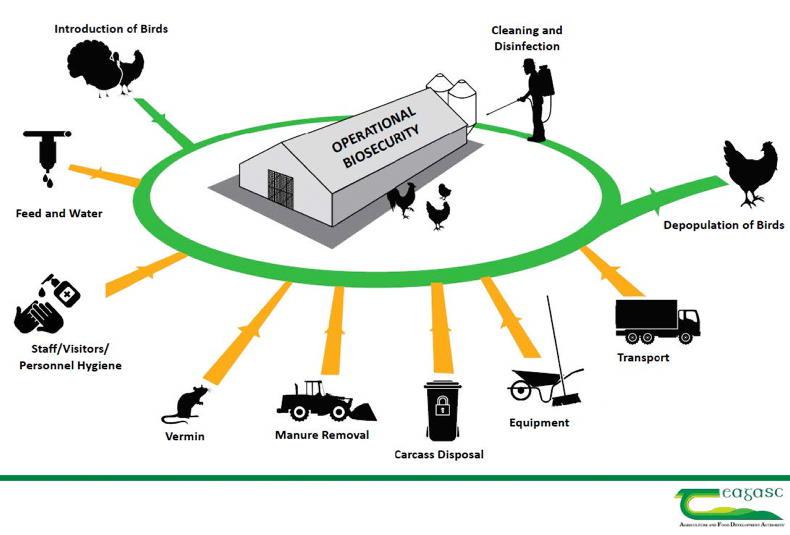
This can be further divided into external and internal biosecurity.
External biosecurity is concerned with preventing the introduction of disease-causing agents into the unit, such as HPAI. This will focus on the inputs into the farm, i.e. the producer, external staff, birds, feed and water.
Staff and visitors
It is widely understood that pathogens can be transferred via humans. Humans can carry disease-causing agents on their body (hair/skin/under fingernails), clothes and/or shoes. During this high-risk period, only essential people should be permitted access to the site.
A visitor log must be maintained, which should contain the following:
Date of visit.Name of visitor.Company.The purpose of the visit.The last poultry site visited.Vehicle registration numberAll staff or visitors, who must come on farm, are obliged to comply with the biosecurity measures being implemented on farm. Producers should have house-specific footwear for each house. Where possible these should be bio-secure boots. These boots have smooth soles. This prevents material and potential bacteria from being carried from one house to another. It would also be advisable for producers to have overalls for each house. As noted earlier, pathogens can be carried on people’s clothing.
If a visitor must come on-site and must enter the production house, it is crucial they wear personal protection equipment* (PPE). This must include disposable boot covers, disposable overalls, gloves, face mask and a hair net. This PPE should be disposed of, on the site of use. (* In this case, PPE should stand for poultry protection equipment!)
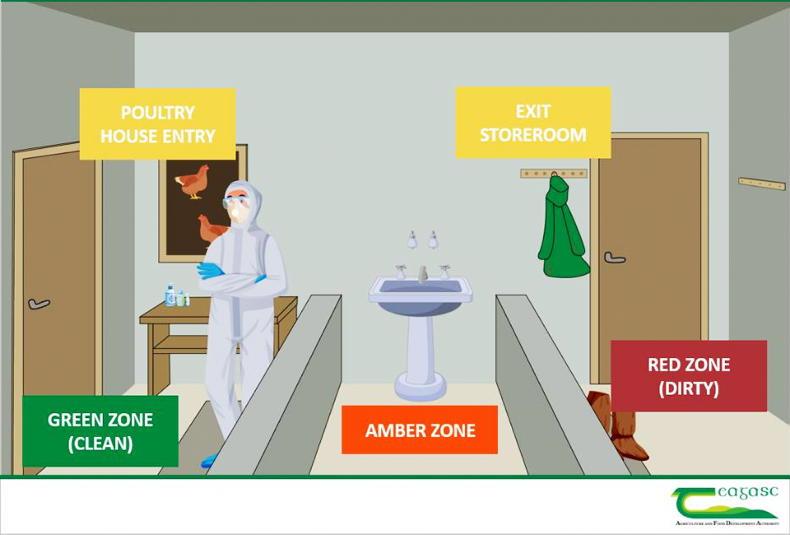
Foot dips must be available on entry to the production house. These should be covered to prevent dilution from rain water. Alternatively, a footdip should be available inside the door before crossing the stepover barrier. This can improve effectiveness in colder temperatures. A foot dip should be changed as required. The more use a gets, the more regular it should be changed.
Vehicles
Vehicles can be a common source of infection, particularly if they are visiting more than one poultry site on a given day. While it is best to prevent vehicles coming on site at all, it is clearly necessary for feed lorries, egg collection lorries, gas lorries, etc to come on site. For those who do not have to come on-site, safe parking should be made available at the site entrance. For the essential vehicles, it is critical to provide wheel sprays and vehicle disinfection at the entrance. It is advisable to have this as close to the point of drop-off/collection, to prevent any re-contamination on roadways.
Pest control
It is evident that mice and rats would be attracted to poultry units due to the feed supply, heat and dry lying. However, these vermin can be transmitters of pathogens and, therefore, must be prevented from entering the production house, coming in contact with feed and water and generally kept away.
Ensuring your rodent control plan is in place and being implemented. In conjunction with a rodent control plan, the following additional measures must be adhered to also:
Any feed spillages must be cleaned up immediately.Prevent any pools of water accumulating.Keep the unit generally tidy – no rubbish build-up as this can provide a nesting area.Ensure dead bins are kept sealed and locked.Ensure the building is fully sealed with no access points.These measures can also be crucial for preventing the attraction of wild birds to an area. It is crucial to deter birds from the site. The concrete apron to the house front should be washed down and disinfected regularly, as this is a high traffic area where all staff will cross over before entering the production house.
Stepover barriers
A stepover barrier creates a distinct and clear message – the clothing and footwear must be changed at this point. The stepover barrier indicates a clean and dirty zone.
The stepover barrier can be either one-step or two-step.
One-step carrier system:
Upon entry into the store, the person must either remove their outdoor clothing and footwear and put on house-specific clothing or disposable overalls can be put on at this point. Any visitor should have disposable overalls and boot covers on at this point already.The person will then sit on the barrier, putting on house-specific footwear. A visitor will put on a second pair of boot covers at this point.Hand sanitiser should be available again at the door to the poultry house.On exit from the clean zone, to the dirty zone, the outer boot covers must be removed and placed in a rubbish bin within the dirty zone.Two-step Barrier System:
A two-step barrier system will have three zones – green (clean), amber, and red (dirty).Upon entry to the red zone (dirty zone), the person will remove their outdoor footwear, stepping into the amber zone in stocking feet.Within the amber zone, hands must be washed and sanitised.Crossing from the amber zone to the green zone, a new pair of boot covers is required, or the use of house specific clothing and footwear.Hand sanitiser should be available again at the door to the poultry house.On exit from the green zone to the amber zone, the outer boot covers must be removed and placed in a rubbish bin within the dirty zone.HPAI Symptoms
It is crucial that all producers follow the stringent biosecurity measures which have been introduced by the Department.
All producers should be vigilant for any disease which cannot be explained. If they suspect bird flu this should be reported to their nearest Regional Veterinary Office and their veterinary practitioner.
Symptoms include:
Death/high mortalities.Depression/lethargy.Loss of appetite.Respiratory distress (gaping beak, coughing, sneezing, gurgling, rattling).Swelling and blue discolouration of combs, wattles, neck and throat.Diarrhoea.Reduced egg production/no egg production.The disease poses no food safety risk for consumers. Properly cooked poultry and poultry products, including eggs are safe to eat.
For more information, visit the Department of Agriculture, Food and the Marine website. The National Disease Control Centre release updates on a regular basis. You can subscribe on the Department’s website.
Avian Influenza, or bird flu as it is commonly known, generally poses a threat to the poultry industry from October onwards. However, 2022 has been very unusual, with commercial cases in the UK throughout the year and wild bird cases beginning here in early July. At the time of writing, there have been two commercial cases confirmed in Ireland. These have both been in turkey flocks in Co Monaghan. All birds have been culled on these sites as a result.
As a result of a confirmed highly pathogenic avian influenza (HPAI) outbreak, restriction zones have been put in place. Within these zones, there are additional protection and surveillance required. All poultry keepers in these zones are legally required to comply with the regulations.
Biosecurity is crucial for the protection of poultry units, now more so than ever. While the Department of Agriculture, Food and the Marine has introduced a housing order from 7 November, biosecurity must remain in place in the strictest of measures.
Biosecurity is a set of preventative measures put in place to reduce the risk of introducing harmful bacteria, viruses or pathogens; and minimise the spread of already present disease-causing agents throughout the farm.
Operational biosecurity is ever more important in times of high disease risk. These are the day-to-day measures put in place by the farmer to ensure the farm is free from disease (see graph below).

This can be further divided into external and internal biosecurity.
External biosecurity is concerned with preventing the introduction of disease-causing agents into the unit, such as HPAI. This will focus on the inputs into the farm, i.e. the producer, external staff, birds, feed and water.
Staff and visitors
It is widely understood that pathogens can be transferred via humans. Humans can carry disease-causing agents on their body (hair/skin/under fingernails), clothes and/or shoes. During this high-risk period, only essential people should be permitted access to the site.
A visitor log must be maintained, which should contain the following:
Date of visit.Name of visitor.Company.The purpose of the visit.The last poultry site visited.Vehicle registration numberAll staff or visitors, who must come on farm, are obliged to comply with the biosecurity measures being implemented on farm. Producers should have house-specific footwear for each house. Where possible these should be bio-secure boots. These boots have smooth soles. This prevents material and potential bacteria from being carried from one house to another. It would also be advisable for producers to have overalls for each house. As noted earlier, pathogens can be carried on people’s clothing.
If a visitor must come on-site and must enter the production house, it is crucial they wear personal protection equipment* (PPE). This must include disposable boot covers, disposable overalls, gloves, face mask and a hair net. This PPE should be disposed of, on the site of use. (* In this case, PPE should stand for poultry protection equipment!)

Foot dips must be available on entry to the production house. These should be covered to prevent dilution from rain water. Alternatively, a footdip should be available inside the door before crossing the stepover barrier. This can improve effectiveness in colder temperatures. A foot dip should be changed as required. The more use a gets, the more regular it should be changed.
Vehicles
Vehicles can be a common source of infection, particularly if they are visiting more than one poultry site on a given day. While it is best to prevent vehicles coming on site at all, it is clearly necessary for feed lorries, egg collection lorries, gas lorries, etc to come on site. For those who do not have to come on-site, safe parking should be made available at the site entrance. For the essential vehicles, it is critical to provide wheel sprays and vehicle disinfection at the entrance. It is advisable to have this as close to the point of drop-off/collection, to prevent any re-contamination on roadways.
Pest control
It is evident that mice and rats would be attracted to poultry units due to the feed supply, heat and dry lying. However, these vermin can be transmitters of pathogens and, therefore, must be prevented from entering the production house, coming in contact with feed and water and generally kept away.
Ensuring your rodent control plan is in place and being implemented. In conjunction with a rodent control plan, the following additional measures must be adhered to also:
Any feed spillages must be cleaned up immediately.Prevent any pools of water accumulating.Keep the unit generally tidy – no rubbish build-up as this can provide a nesting area.Ensure dead bins are kept sealed and locked.Ensure the building is fully sealed with no access points.These measures can also be crucial for preventing the attraction of wild birds to an area. It is crucial to deter birds from the site. The concrete apron to the house front should be washed down and disinfected regularly, as this is a high traffic area where all staff will cross over before entering the production house.
Stepover barriers
A stepover barrier creates a distinct and clear message – the clothing and footwear must be changed at this point. The stepover barrier indicates a clean and dirty zone.
The stepover barrier can be either one-step or two-step.
One-step carrier system:
Upon entry into the store, the person must either remove their outdoor clothing and footwear and put on house-specific clothing or disposable overalls can be put on at this point. Any visitor should have disposable overalls and boot covers on at this point already.The person will then sit on the barrier, putting on house-specific footwear. A visitor will put on a second pair of boot covers at this point.Hand sanitiser should be available again at the door to the poultry house.On exit from the clean zone, to the dirty zone, the outer boot covers must be removed and placed in a rubbish bin within the dirty zone.Two-step Barrier System:
A two-step barrier system will have three zones – green (clean), amber, and red (dirty).Upon entry to the red zone (dirty zone), the person will remove their outdoor footwear, stepping into the amber zone in stocking feet.Within the amber zone, hands must be washed and sanitised.Crossing from the amber zone to the green zone, a new pair of boot covers is required, or the use of house specific clothing and footwear.Hand sanitiser should be available again at the door to the poultry house.On exit from the green zone to the amber zone, the outer boot covers must be removed and placed in a rubbish bin within the dirty zone.HPAI Symptoms
It is crucial that all producers follow the stringent biosecurity measures which have been introduced by the Department.
All producers should be vigilant for any disease which cannot be explained. If they suspect bird flu this should be reported to their nearest Regional Veterinary Office and their veterinary practitioner.
Symptoms include:
Death/high mortalities.Depression/lethargy.Loss of appetite.Respiratory distress (gaping beak, coughing, sneezing, gurgling, rattling).Swelling and blue discolouration of combs, wattles, neck and throat.Diarrhoea.Reduced egg production/no egg production.The disease poses no food safety risk for consumers. Properly cooked poultry and poultry products, including eggs are safe to eat.
For more information, visit the Department of Agriculture, Food and the Marine website. The National Disease Control Centre release updates on a regular basis. You can subscribe on the Department’s website.







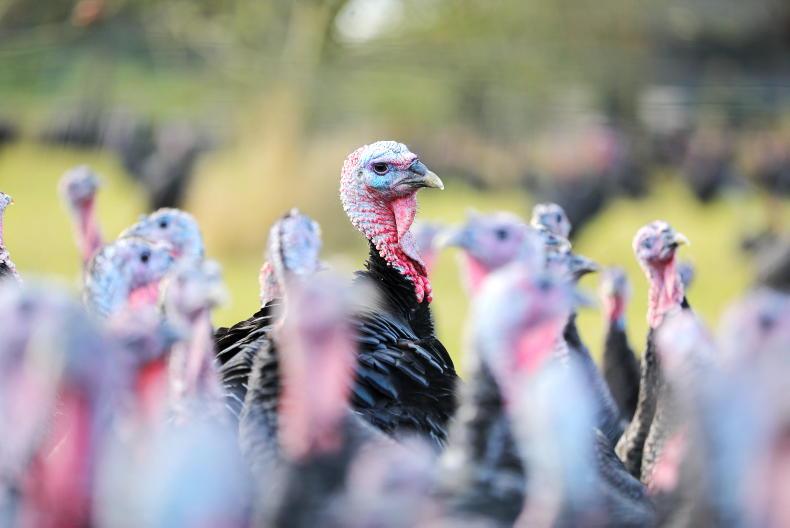

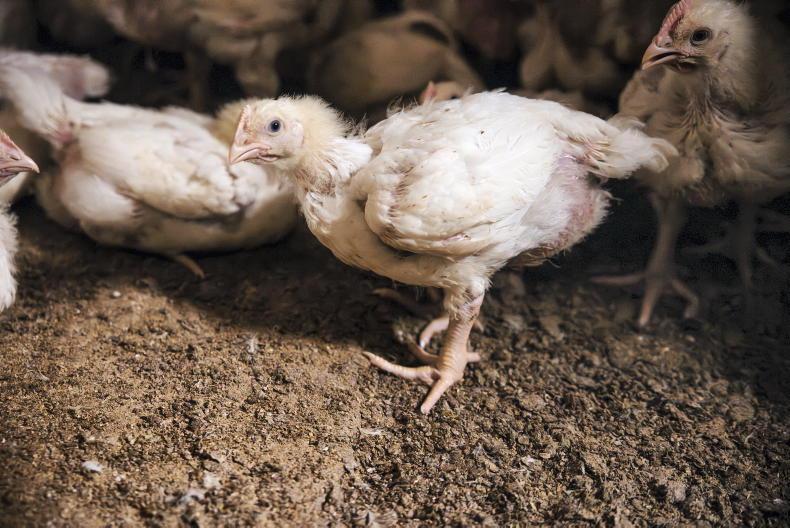
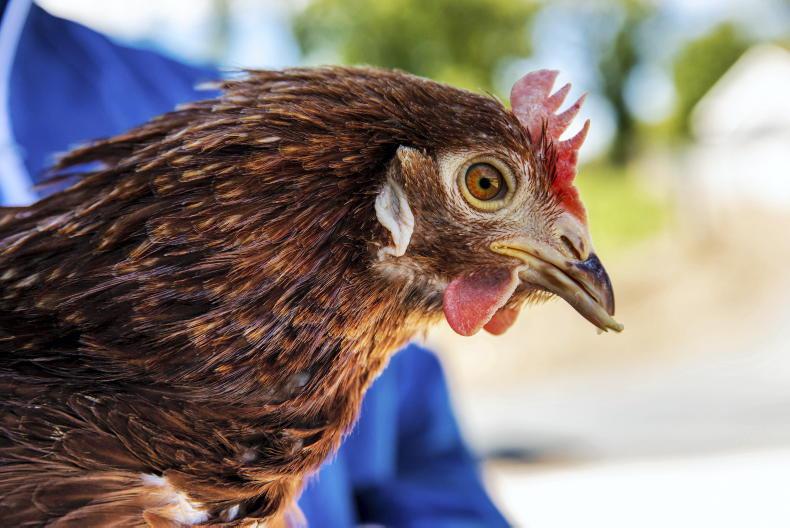
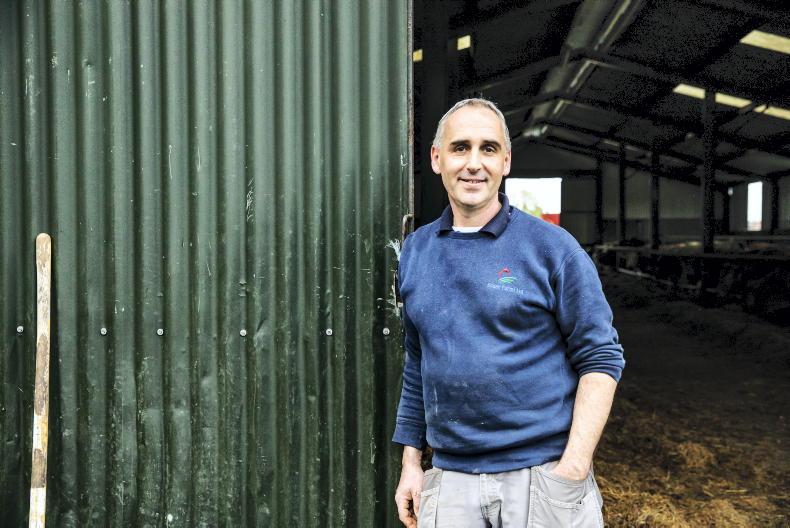
SHARING OPTIONS